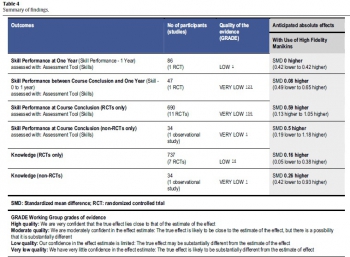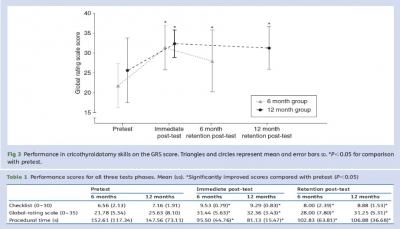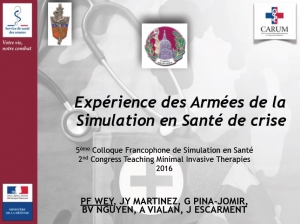19/07/2016
Expérience des armées de la simulation en santé de crise
| Tags : simulateurs
01/08/2015
Simulation préhospitalière: Etat des lieux
Mapping the use of simulation in prehospital care - a literature review
Abelsson et al. Scandinavian Journal of Trauma, Resuscitation and Emergency Medicine 2014, 22:22
BACKGROUND:
High energy trauma is rare and, as a result, training of prehospital care providers often takes place during the real situation, with the patient as the object for the learning process. Such training could instead be carried out in the context of simulation, out of danger for both patients and personnel. The aim of this study was to provide an overview of the development and foci of research on simulation in prehospital care practice.
METHODS:
An integrative literature review were used. Articles based on quantitative as well as qualitative research methods were included, resulting in a comprehensive overview of existing published research. For published articles to be included in the review, the focus of the article had to be prehospital care providers, in prehospital settings. Furthermore, included articles must target interventions that were carried out in a simulation context.
RESULTS:
The volume of published research is distributed between 1984- 2012 and across the regions North America, Europe, Oceania, Asia and Middle East. The simulation methods used were manikins, films, images or paper, live actors, animals and virtual reality. The staff categories focused upon were paramedics, emergency medical technicians (EMTs), medical doctors (MDs), nurse and fire fighters. The main topics of published research on simulation with prehospital care providers included: Intubation, Trauma care, Cardiac Pulmonary Resuscitation (CPR), Ventilation and Triage.
CONCLUSION:
Simulation were described as a positive training and education method for prehospital medical staff. It provides opportunities to train assessment, treatment and implementation of procedures and devices under realistic conditions. It is crucial that the staff are familiar with and trained on the identified topics, i.e., intubation, trauma care, CPR, ventilation and triage, which all, to a very large degree, constitute prehospital care. Simulation plays an integral role in this. The current state of prehospital care, which this review reveals, includes inadequate skills of prehospital staff regarding ventilation and CPR, on both children and adults, the lack of skills in paediatric resuscitation and the lack of knowledge in assessing and managing burns victims. These circumstances suggest critical areas for further training and research, at both local and global levels.
| Tags : simulateurs
02/05/2015
Haute fidélité: Utile ? Pas si sûr
The use of high-fidelity manikins for advanced life support training. A systematic review and meta-analysis
Cheng A et All. Resuscitation. 2015 Apr 14. pii: S0300-9572(15)00152-5
---------------------------------------------------------
Le recours à la simulation apparaît incontournable en pédagogie médicale. L'emploi de mannequins haute fidélité connait un essort majeur. Si la satisfaction des étudiants semble au rendez-vous, il n'est cependant pas si évident que la simulation haute fidélité soit dimensionnante en terme d'acquisition réelle de savoir faire. Les avis sont partagés. Ainsi C'est travail évoque un niveau de preuve relativement faible voir absent. Compte tenu du coût non négligeable des mannequins haute fidélité, un tel investissement doit donc être réfléchi.
--------------------------------------------------------
Objectives:
The objective of this study was to evaluate the effectiveness of high versus low fidelity manikins in the context of advanced life support training for improving knowledge, skill performance at course conclusion, skill performance between course conclusion and one year, skill performance at one year,skill performance in actual resuscitations, and patient outcomes.
Methods:
A systematic search of Pubmed, Embase and Cochrane databases was conducted through January31, 2014. We included two-group non-randomized and randomized studies in any language comparing high versus low fidelity manikins for advanced life support training. Reviewers worked in duplicate to extract data on learners, study design, and outcomes. The GRADE (Grades of Recommendation, Assess-ment, Development and Evaluation) approach was used to evaluate the overall quality of evidence foreach outcome.
Results: 3840 papers were identified from the literature search of which 14 were included (13 randomized controlled trials; 1 non-randomized controlled trial). Meta-analysis of studies reporting skill performanceat course conclusion demonstrated a moderate benefit for high fidelity manikins when compared withlow fidelity manikins [Standardized Mean Difference 0.59; 95% CI 0.13–1.05]. Studies measuring skill performance at one year, skill performance between course conclusion and one year, and knowledge demonstrated no significant benefit for high fidelity manikins

Conclusion:
The use of high fidelity manikins for advanced life support training is associated with moderate benefits for improving skills performance at course conclusion. Future research should definethe optimal means of tailoring fidelity to enhance short and long term educational goals and clinical outcomes.
| Tags : simulateurs
04/04/2015
Simulateur de crico: Encore le modèle porcin
A home-made animal model in comparison with a standard manikin for teaching percutaneous dilatational tracheostomy
Interact Cardiovasc Thorac Surg. 2015 Feb;20(2):248-53

| Tags : coniotomie, simulateurs
21/03/2015
Simulateur ou vecteur biologique ?
Randomized objective comparison of live tissue training versus simulators for emergency procedures
Hall AB. Am Surg. 2011 May;77(5):561-5.
-----------------------------------------------------------------------------------------
La simulation joue un rôle fondamental dans la foration aux gestes du sauvetage au combat. Le recours au vecteur biologique, au cadavre ou à des simulateurs artificiels reste sujet à débat. Le travail proposé montre que les simulatueurs artificiels sont aussi efficaces que les vecteurs biologiques. L'emploi de cadavres apparaît quand à lui poser le problème de leur disponibilité en nombre suffisant.
-----------------------------------------------------------------------------------------
There is a lack of objective analysis comparing live tissue and simulator training. This article aims to objectively determine the difference in outcomes. Twenty-four Air Force volunteers without prior experience performing emergency procedures were randomly assigned to receive training in tube thoracostomy (chest tube) and cricothyroidotomy training on either a pig model (Sus scrofa domestica) or on the TraumaMan simulator. One week posttraining, students were tested on human cadavers with objective and subjective results recorded. Average completion time for tube thoracostomy in the animal model group was 2 minutes 4 seconds and 1 minute 51 seconds in the simulator group with a mean difference of 12 seconds (P = 0.74). Average completion time for cricothyroidotomy in the animal model group was 2 minutes 35 seconds and 3 minutes 29 seconds in the simulator group with a mean difference of 53 seconds (P = 0.32). Overall confidence was 9 per cent higher in the animal trained group (P = 0.42). Success rate of cricothyroidotomy was 75 per cent in the animal model group and 58 per cent in the simulator-trained group (P = 0.67). Success rate of chest tube placement was 92 per cent in the animal group and 83 per cent in the simulator group (P = 1.00). There was no statistically significant difference in chest tube and cricothyroidotomy outcomes or confidence in the groups trained with live animal models or simulators at the 95 per cent confidence interval. Trends suggest a possible difference, but the number of cadavers required to reach greater than 95 per cent statistical confidence prohibited continuation of the study.
| Tags : simulateurs
21/11/2014
Simuler 1 fois par an: Suffisant ?
Complex procedural skills are retained for a minimum of 1 yr after a single high-fidelity simulation training session
Boet S.et All. Br. J. Anaesth. (2011) 107 (4): 533-539
-----------------------------------------------------------------------------------
Certaines procédures de mise en condition de survie sont rarement réalisées en conditions réelles. Pourtant leur maîtrise par le personnel qui intervient doit être acquise. Se pose dès lors le problème de l'acquisition et du maintien de ces compétences techniques. la simulation est un moyen d'y parvenir. La coniotomie fait partie des ces gestes. Récemment il a été mis en avant que 5 réalisations simulées par des professionnels de l'urgence permettaient d'obtenir une relative maîtrise techniqe mais que cette dernière ne se maintenait pas au delà de 6 mois. (1). Le travail présenté confirme ces données.
-----------------------------------------------------------------------------------
Background. Simulation has been shown to be effective in teaching complex emergency procedural skills. However, the retention of these skills for a period of up to 1 yr has not been studied. We aimed to investigate the 6 month and 1 yr retention of the complex procedural skill of cricothyroidotomy in attending anaesthetists using a high-fidelitysimulated cannot intubate, cannot ventilate (CICV) scenario.
Methods. Thirty-eight attending anaesthetists participated individually in a high-fidelitysimulated CICV scenario (pretest) that required a cricothyroidotomy for definitive airway management. Immediately after a debriefing and structured teaching session on cricothyroidotomy insertion, subjects managed a second identical CICV scenario (posttest). Each anaesthetist was randomized to either a ‘6 month retention’ or a ‘12 month retention’ group. No further teaching occurred. At their respective retention times, each anaesthetist managed a third identical CICV scenario (retention post-test). Two blinded experts independently rated videos of all performances in a random order, using a specific checklist (CL) score, a global-rating scale (GRS) score, and procedural time (PT).

Results. Subjects from both groups improved on their cricothyroidotomy skill performances from pretest to immediate post-test and from pretest to retention post-test, irrespective of the retention interval; CL mean (SD) 8.00 (2.39) vs 8.88 (1.53), P¼0.49; GRS 28.00 (7.80) vs 31.25 (5.31), P¼0.25; PT 102.83 (63.81) s vs 106.88 (36.68) s, P¼0.73.
Conclusions. After a single simulation training session, improvements in cricothyroidotomy skills are retained for at least 1 yr. These findings suggest that high-fidelity simulation training, along with practice and feedback, can be used to maintain complex procedural skills for at least 1 yr
| Tags : simulateurs
14/09/2013
Réalité augmentée et sauvetage au combat: Bientôt ?
Using augmented reality as a clinical support tool to assist combat medics in the treatment of tension pneumothoraces.
Wilson KL et All. Mil Med 2013; 178(9):981-5
----------------------------------------------------------------------------------------
La réalité augmentée désigne les systèmes informatiques qui rendent possible la superposition d'un modèle virtuel 3D ou 2D à la perception que nous avons naturellement de la réalité et ceci en temps réel. La commercialisation récente des Google glass est le témoin d'une technologie qui devient mature. Dès lors il n'est pas étonnant qu'un tel dispositif soit utilisé dans les domaines de la formation voire en conditions réelles. Le travail présenté ci-après n'est qu'un exemple.
----------------------------------------------------------------------------------------
This study was to extrapolate potential roles of augmented reality goggles as a clinical support tool assisting in the reduction of preventable causes of death on the battlefield. Our pilot study was designed to improve medic performance in accurately placing a large bore catheter to release tension pneumothorax (prehospital setting) while using augmented reality goggles. Thirty-four preclinical medical students recruited from Morehouse School of Medicine performed needle decompressions on human cadaver models after hearing a brief training lecture on tension pneumothorax management. Clinical vignettes identifying cadavers as having life-threatening tension pneumothoraces as a consequence of improvised explosive device attacks were used. Study group (n = 13) performed needle decompression using augmented reality goggles whereas the control group (n = 21) relied solely on memory from the lecture. The two groups were compared according to their ability to accurately complete the steps required to decompress a tension pneumothorax. The medical students using augmented reality goggle support were able to treat the tension pneumothorax on the human cadaver models more accurately than the students relying on their memory (p < 0.008). Although the augmented reality group required more time to complete the needle decompression intervention (p = 0.0684), this did not reach statistical significance.
| Tags : pédagogie, simulateurs
27/06/2013
DU Fosei
A partir de la rentrée universitaire 2013 et dans le cadre du projet SAMSEI , l'université de médecine proposera une formation à la simulation. Fidèle au principe d'enseignement par ilmmersion ce DU est conduit avec l'ensemble des structures universitaires lyonnaises mais aussi le service de santé des armées notamment le CITERA de l'HIA Desgenettes, Le Cefos et l'Institut de recherche du SSA.
Les modalités pratiques d'inscription à ce DU sont disponibles sur ce lien.
| Tags : simulateurs
11/12/2011
Quel modèle pour apprendre la coniotomie ?
L'apprentissage de ce geste est fondamental et fait appel le plus souvent à des simulateurs dont l'inconvénient est le coût élevé des pièces de rechange. Un des plus performants est le TraumaMan relativement onéreux. Des simulateurs moins performants existent (1, 2, 3, 4, 5). Certains ont développé des systèmes artisanaux plus ou moins sophistiqués qui n'ont pas cet inconvénient (6, 7, 8). Ces derniers permettraient un apprentissage de qualité identique à des modèles sophistiqués. Les modèles animaux ne seraient pas tous appropriés notamment le modèle canin, ce qui semble être moins vrai avec un modèle porcin. L'apprentissage exclusif sur cadavre est difficilement envisageable. La meilleure approche est certainement d'acquérir cette compétence d'abord sur mannequins et de finaliser par l'apprentissage sur cadavre. 5 gestes réussis semblent être requis.
| Tags : simulateurs, pédagogie

